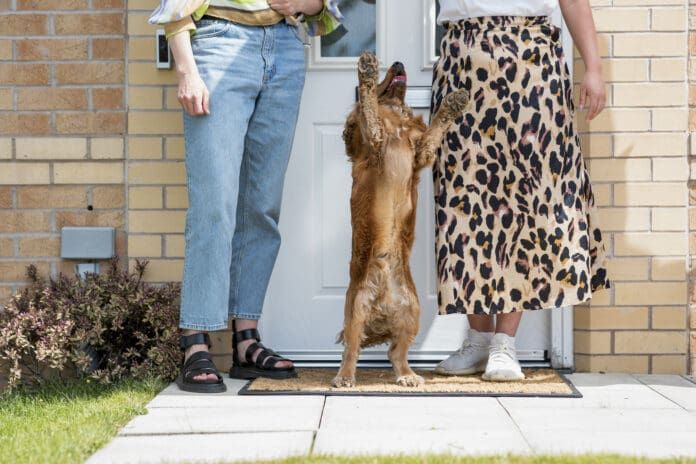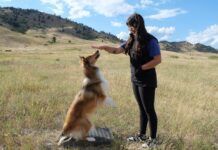There are quite a few behaviors that are normal and natural for dogs that just don’t work very well in the human world. Whether it’s humping other dogs or barking at the neighbor’s cat, these behaviors can be disruptive and, in some cases, can even lead to a dog being surrendered or rehomed. Luckily, there are often training solutions for these common dog behavioral issues.
How to Stop a Dog from Digging
Digging is a natural, normal behavior for many dogs but that doesn’t mean you have to put up with holes everywhere. To stop a dog from digging, you first need to understand where the behavior is coming from.
There are a number of reasons dogs dig including to explore, relieve boredom or stress, create a cool spot to rest in, escape, chase underground critters, or just for the fun of it. Given that digging often stems from boredom or looking for some fun, one of the best ways to reduce the urge is by making sure your dog is getting enough mental stimulation and exercise. Walks, training, enrichment toys, playtime, and socialization can all help liven up a dog’s life and keep him from turning to behaviors—like digging—that you would prefer he avoid.
The more your dog loves to dig, the harder it will be to get him to stop. You can remove temptation by:
- Locating any areas in the yard that might be particularly inviting for digging—such as gopher holes and loose dirt piles—and keeping your dog away from them. To do so, you will need to supervise your dog in the yard or use a dog run or exercise pen.
- Giving your dog an area where he is allowed to dig can also help prevent holes in spots you’d rather keep un-dug. If your dog is already an established digger, try creating a digging pit for him by filling a kid’s sandbox or plastic wading pool with sand or dirt and burying his toys in it. Introduce him to the game by showing him the digging pit and helping him uncover a few toys.
- Replacing most of the dirt and an already-dug hole, adding collected dog feces to the hole, and covering it the rest of the way up. With several repetitions, this may discourage some dogs from digging.
Finally, if your dog is digging to get out of a fenced yard or pen, you will probably need to build a better fence. If you can’t be there to supervise, there’s no easy way to compete with all of the excitement on the other side of a barrier.
For a closer look, see “What to Do if Your Dog Digs Where You Don’t Want Him To.”
How to Stop a Dog from Eating Poop
“Coprophagia,” or poop eating, is one of the grosser things—from a human perspective—that dogs do. While eating poop is normal for dogs, the behavior can cause problems beyond just the ick-factor since it puts dogs at risk of contracting intestinal parasites and diseases such as parvovirus. It can also be a symptom of an underlying medical condition or nutritional deficiency.
For this reason, the first step you should take if your dog is eating poop is to have her examined by a veterinarian to rule out any possible medical causes. If she gets a clean bill of health, your best bet will be developing strategies for managing the behavior. These can include:
- Cleaning up after your dog as soon as possible.
- Removing access to other animal feces such as putting cat litterboxes out of reach.
- Teaching a ‘leave it’ cue and supervising your dog.
- Training your dog to be comfortable in a basket muzzle. (As with any new equipment, do NOT just put a muzzle on a dog who has never worn one before. You will need to develop a training plan that creates a positive association with the muzzle.)
Coprophagia can also be caused by boredom, stress, and anxiety. Increasing the amount of mental stimulation your dog is getting and working with a trainer to identify and address any stress or anxiety your dog is feeling may help stop a dog from eating poop.
For further information, see “Help! Why Does My Dog Eat Poop?”
How to Train a Dog to Stop Barking
Barking is one of the primary ways dogs communicate but it can become a problem when a dog barks too much, too loudly, or at the wrong time for her human companions. To train a dog to stop barking, you first need to figure out why she is vocalizing. Depending on the reason, you can use techniques such as counterconditioning and desensitization, training a positive interrupt, and ignoring the behavior to help modify excessive barking.
Common reasons for barking include:
- Alarm/Alert: Dogs will bark to let human and canine companions know that there is something dangerous or interesting nearby. Counterconditioning and desensitization and use of a positive interrupt can help.
- Anxiety: Some dogs will bark when they are nervous or afraid. Consult with a professional behaviorist to better assess how to manage your dog’s anxiety.
- Boredom: As with many other “problem” behaviors, a lack of mental stimulation and exercise can result in a dog who barks for entertainment. Whether it’s taking her with you to run errands or introducing her to puzzle toys, find more for the dog to do.
- Demand: Some dogs will bark when they want something—like attention or treats. To reduce demand barking, ignore your dog when she is barking and reward her when she is quiet.
- Frustration: While similar to demand barking, frustration barking is directed at the thing the dig can’t have. Use a positive interrupt along with counterconditioning and desensitization.
- Greeting/Excitement: Dogs will often bark when they are excited or to say hello—like when you come home after a long day at work. As with demand barking, ignore your dog until she is calm and greet her once she is quiet.
- Play: Many dogs bark during play. If it gets to be too much, a “time-out” technique where you remove your dog from play for a few minutes—usually by putting her on a short leash—can help. You can also teach her to hold a toy in her mouth.
For a more detailed look at types of barking and how to modify them, see “How to Stop a Dog from Barking.”
How to Stop a Dog from Humping
Despite common misconceptions, humping behavior in dogs is generally not due to either an intent to reproduce or displays of dominance. It is normal canine behavior and both male and female dogs will hump other dogs—or furniture, toys, cushions, and even humans—for reasons including play, stress or anxiety, excitement, attention-seeking, and masturbation. It can also (rarely) be a symptom of obsessive-compulsive disorder (OCD).
While humping behavior is natural for dogs, it can become a nuisance to humans and other dogs alike. To stop a dog from humping try the following steps:
- First, speak with your vet to rule out any potential medical causes for the behavior.
- Increase how much exercise and mental stimulation your dog is getting.
- Reduce stress.
- Train and use a positive interrupt such as “Walk Away” to stop the behavior while it is happening.
- Train for good manners (polite greetings, down, touch, place, etc.).
- Consult with a reputable fear-free trainer or behaviorist if the behavior persists.
For an in-depth discussion, see “Why Do Dogs Hump (and What You Can Do).”
How to Stop a Dog from Jumping on People
From muddy pawprints to knocking someone over, jumping up on people is not a behavior to encourage. There is no single answer for how to stop a dog from jumping on people. Dogs jump up for a number of reasons—to get attention, to say hello, to get information, or for comfort—and each requires a different approach.
If your dog is jumping on people to get attention or to say hello, the best method for stopping the behavior is by training and generously reinforcing incompatible behaviors. The goal is to teach your dog that attention comes when she sits politely:
- Be prepared and reward her with treats or attention before she has a chance to jump up.
- When out in public, let people who ask to say hi to her know that they can pet her if she sits but to please stop and back up if she jumps.
- If she has trouble sitting still (or just for fun!), teach other cues incompatible with jumping such as “Search” or have visitors throw a toy for her when they walk in the door.
If your dog is jumping on people to get information about them—which can happen when a dog is uncertain or cautious around new people—it’s best to prevent direct interaction until the dog is more comfortable. Do not let the new person pet or approach the dog—or the dog approach the person—until the dog is relaxed and comfortable.
If your dog is jumping up to seek comfort, it’s okay to comfort her. If possible, comfort her before she has a chance to start jumping. Stay calm, remove the frightening thing if possible, and figure out what works to make her feel better (holding her, petting her, doing some training exercises, favorite treats, etc.). If nothing seems to work or if the behavior worsens, don’t be afraid to contact a behaviorist or trainer for help.
For more information, see “How to Stop Your Dog From Jumping on People.”
Finally, don’t forget that you are not alone! For any dog behavioral issues where you are feeling stuck, seek help from a force-free trainer or certified behaviorist.






